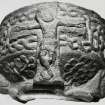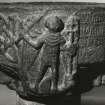Skye, Eynort, St Maelrubha's Churches, St Michael's Font
Font (Medieval)
Site Name Skye, Eynort, St Maelrubha's Churches, St Michael's Font
Classification Font (Medieval)
Alternative Name(s) Borline; Kilmory Church
Canmore ID 99185
Site Number NG32NE 1.02
NGR NG 3757 2599
Datum OSGB36 - NGR
Permalink http://canmore.org.uk/site/99185
- Council Highland
- Parish Bracadale
- Former Region Highland
- Former District Skye And Lochalsh
- Former County Inverness-shire
Field Visit (15 May 1915)
Church (Kilmoruy (Maolrubha)), Borline.
At Borline on the western shore of the inner end of Loch Eynort are two roofless churches, the larger probably of the 18th century and the smaller earlier. The latter is an oblong structure, orientated 102 ½ deg. mag., and measuring 26 feet 5 inches in length and 15 feet 8 inches in breadth externally. The walls, 2 feet 5 inches thick, still stand 7 feet 6 inches high above present level of interior. The wall head is angled to conform with the slope of the thatch. Some 10 feet 2 inches from the floor at the east end there is a scarcement on the gable, the same feature appearing in the west gable. The door, 2 feet 7 inches wide and now 4 feet high, with checks on either side and widely splayed internally, is placed 12 feet 2 inches from the east end of the south wall, and a window 7 feet 4 inches from the west end measures 11 inches wide at the outside and 2 feet 6 inches high. There are also windows in the west end and northern wall, the former 11 inches wide and 2 feet 6 inches high, and the latter, which is placed 6 feet 3 ½ inches from the east end, 1 foot 3 ½ inches wide. A window in the east end is placed 6 feet from the ground. The windows have jambs rounded at corners, 7 ½ inches deep and with a rebate 1 ½ inches deep inside, behind which they are widely splayed.
The later church lies a short distance to the west.
FONT (NG32NE 1.1). A fine font of 15th or 16th-century date which was found in the churchyard is now preserved in the National Museum of Antiquities, Edinburgh, and the circumstances of its discovery and preservation have been fully related in the Proc. Soc. Ant. Scot., Vol. XXI., pp. 412-8. The bowl, of hornblendic gneiss, is circular, and it has no drain. The exterior is embellished with figure subjects and other designs in high relief (Figs. 195-6-7-8-9). The four figure subjects, representing The Crucifixion ,St Michael, The Virgin and Child, and a mitred bishop, are so arranged as to divide the bowl into four panels, two of which, one on either side of the Crucifixion representation, are occupied by an effective interlaced work, while the other two bear very worn inscriptions, in part almost obliterated, that have not, so far, been deciphered. A date, apparently MCCCCXXX, is faintly discernible. The lower portion of the bowl recedes in sloping and tapering panels, between the figures, three of these panels being ornamented by foliaceous designs, and the fourth by a conventional rose. Beneath the, figures there are four slight rolled projections with the ends returning on each sloping panel near its centre. The dimensions are: diameter of bowl 1 foot 6 ½ inches; height of bowl 13 inches; diameter internally 12 ¾ inches; depth 7 ½ inches
CROSS SHAFT (NG32NE 1.2). Near the centre of the kirkyard is the fragment of a cross shaft broken at both ends measuring 4 feet 9 inches in length and tapering from a width of 11 ½ inches and a thickness of 3½ inches at the base to a width of 8½ inches and a thickness, of 2¾ inches at the top. On the front of the shaft, in a panel bordered by two broad mouldings with a narrow beading between, is the figure of an abbot 14½ inches in length carved in high relief. He is clad in alb, chasuble, stole and amice, and has a rather high mitre on his head, from the right side of which depends an infula. His right hand has two fingers raised in the act of benediction and his left hand grasps a crozier, the crook of which runs into the moulding on the edge of the panel. He is placed under a plain canopy with pointed arch. Above is the figure of Christ on the Cross, the break in the stone being just below the waist; the legs are bare with one foot superimposed on the other; the shaft of the cross to which he is nailed has ragged edges. On the dexter side of the panel alongside the moulding is the inner half of what appears to be a palm branch, being a design with deeply serrated edges. On the back of the shaft is a panel bordered by a single flat moulding and bearing a foliaceous and zoomorphic design. On either side of a central wavy stem springs a conventional foliaceous pattern, the lower portion taking the form of five spiked holly leaves and the higher of rosettes of five and six petals. The top of the stem terminates in a bunch of foliage. The animal at the base shows the head elevated and mouth open; the feet are provided with sharp claws and three of them remain on the ground, while the fourth, one of the fore feet, is raised in the air. The tail curves forward between the legs and upwards across the body and is continued as the stem of the foliaceous design. (Figs. 266, 267.)
CARVED SLABS. There are four grave slabs of dark blue mica schist in the burying ground with a claymore, or one and a half-handed sword, and foliaceous designs carved on their upper surface. Near the west end of the churchyard is the best preserved slab, which measures 5 feet 8 inches in length, 20 inches in width at the top and 16½ inches at the base, and 3 inches in thickness (Fig. 245). It is bordered with a flat moulding and a bead inside and is divided into two divisions. The upper panel bears a cross of eight rays with a foliaceous design between them and also in the four corners. Beneath is a claymore with straight quillons terminating in a quatrefoil with three slight projections placed crosswise; the pommel is circular with a blunt spike on the top. Beneath the quillon on the dexter side is an animal with one of the forepaws raised, and the tail brought forward between the legs and recurved over the haunch is the commencement of an interlaced foliaceous design carried to the foot of the slab. On the sinister side is a somewhat similar design, only the animal has a round, human-like face with protruding ears. On either side of the hilt the ornamentation has been obliterated. The second slab lies beside the last and bears a claymore with quillons set at right angles to the hilt and a foliaceous design on either side. Above is a rayed cross. The stone is much worn and slightly broken.
The third slab, which also lies at the west end of the enclosure, is even more defaced, but a claymore is distinguishable.
The last slab lies near the centre of the kirkyard. It is 6 feet 4 inches long, and has been over 22 inches wide at the top and 18 inches at the bottom. There is a rayed and floriated cross in the top panel and below a claymore with depressed quillons flanked on either side by a foliaceous design. The ornamentation is almost obliterated.
Lying near the cross shaft is a discoid stone of dark blue mica schist, measuring from 20 to 22 inches in diameter and 7 inches in thickness. On the top is a circular stone of about 11 inches diameter and 3 inches thickness with a festooned moulding round the outside and pierced by a hole in the centre 3½ inches square. There is also a moulded stone, possibly part of a lintel or jamb.
RCAHMS 1928, visited 15 May 1915.
OS map: Skye xxxvii.






























